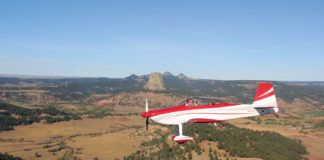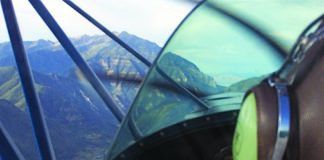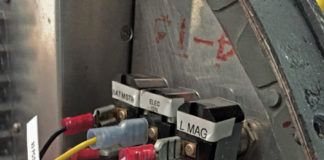Dale Kramer created one of the most popular ultralights of the 1970s: the Lazair. More than 1200 were sold, and hundreds are still flying. Originally powered by a pair of Pioneer chainsaw engines ostensibly putting out 5.5 horsepower each, the translucently covered, dragonfly-like aircraft performed admirably and reliably.
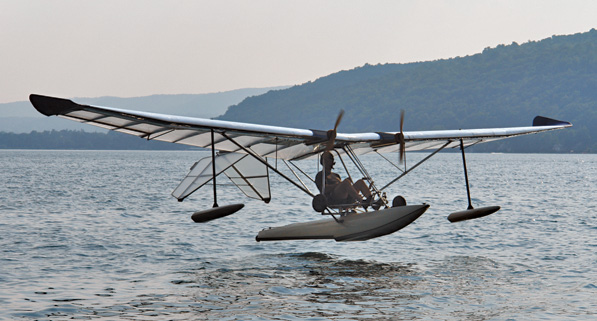
A monohull float and outriggers, plus retractable wheels, make for a highly capable ultralight flying experience.
The long, tapered wings and inverted V-tail gave the airplane a distinctive look, and its clever engineering made it strong and maneuverable enough to be retained, sought out and restored by enthusiasts. One even hangs in the Smithsonian.
In efforts to increase takeoff and climb performance, Kramer and others tried several different engines, the most popular of which seems to have been the single-cylinder Rotax 185cc, 9.5-hp unit. Several Lazairs with these engines use a “biplane” dual-propeller system, with one 28-inch diameter blade immediately behind another on the same shaft. This “fix” apparently added just enough oomph to allow larger pilots to get airborne; KFM and JPL twins were available, which gave a fivefold boost in power over the original Pioneer-powered units and allowed development of a two-seat trainer version.
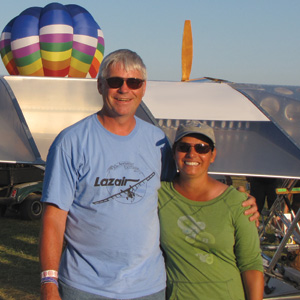
Dale Kramer and his wife, Carmen, celebrate their winning week at Oshkosh.
Kramer knew from experience that a Lazair, at 30 mph, could stay airborne on 3 or 4 kilowatts of power, so about 10 years ago he began thinking seriously about electric power for his ultralight. Indeed, Paul Dewhurst and Paul Robertson in the U.K. flew a Lazair powered by two Plettenberg model motors in early 2009, verifying Kramer’s hypothesis.
Catching Up With Technology
Noting the revolution his little airplane helped create in the late 1970s, Kramer believes that another revolution is possible now. “The RC model aircraft industry is propelling this revolution with the batteries, chargers and power systems we see today,” he said.
Starting with powerful and inexpensive Chinese-made model airplane motors, Kramer devised a hinged, drop-down battery tray, an elegant throttle quadrant that uses a model aircraft servo tester to modulate the power output of the motors and a means to recharge the 100 pounds of batteries nestled in the wings, close to the airplane’s center of gravity.
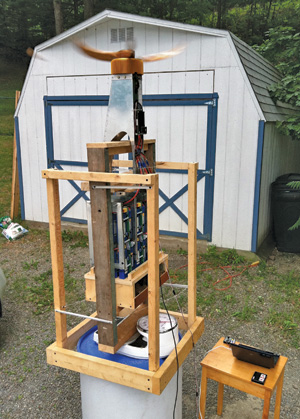
A Joby JM1 motor on Kramer’s test stand. Note the highly precise thrust measurement apparatus.
Testing revealed shortcomings in the model motors, and Kramer attempted to modify them to gain the power and reliability he was hoping to attain. He finally chose a more expensive, but so far, better option, going with JoeBen Bevirt’s JM1 Joby motor. At about 6 pounds for 10 kW, the motor is of similar weight to the original model motor, and has excellent torque and power characteristics.
Kramer modified the model airplane controllers by replacing existing capacitors, which he found to be Super Glued to the circuit boards, with low equivalent series resistance (ESR) capacitors to ease fluctuations on the lines from the battery packs to the motors.
Safety being paramount, Kramer also considered the possibility of fire from thermal runaways in the batteries, and positioned the batteries so that flames would exit top and bottom through the Mylar covering without harming the adjacent structure. He notes that he knows the airplane will fly even if it’s missing the section of wing covering above the batteries. (How he discovered this is subject to wild speculation.)
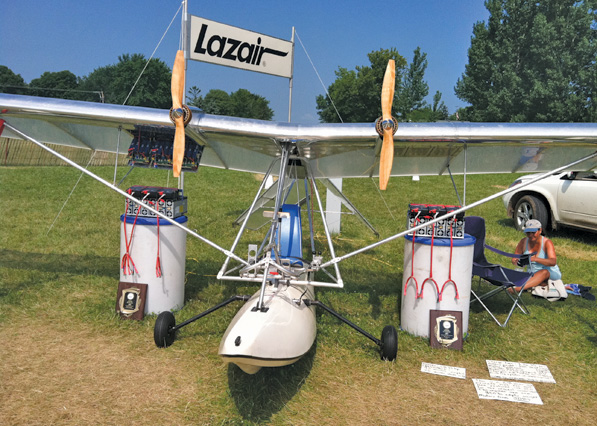
The Lazair with two AirVenture 2011 awards: Antique Ultralight Champion and Best Ultralight Seaplane.
To make sure charging gives the maximum endurance, he uses an FMA PowerLab8, which can charge eight cells in series (but is not limited to that) and is rated for an output of up to 1344 watts at 40 amps.
According to Kramer, when you connect packs in parallel, the charger simply sees it as a single pack with larger capacity cells. A pack of eight cells in series, forming one parallel line of batteries (8S1P) with 2000 milli-amp-hour (mAh) capacity, if connected in parallel to another identical pack, forms an 8S2P 4000 mAh pack. One more pairing makes two such packs into an 8S4P bundle. The charger can charge, and almost more importantly, balance that pack, divvying up the electrons in equal parcels to each cell. That’s the purpose of battery management systems, and they help ensure long battery life and maximum run time for each flight. Kramer even has a flashing alarm to monitor the state of the throttle quadrant battery.
Home Work
Kramer normally recharges the pack outside, or if in the house, in a fireplace with the damper open. A protection circuit board (PCB) on each battery pack monitors groups of cells during charging, and he can isolate an individual defunct cell through observing the status of a group.
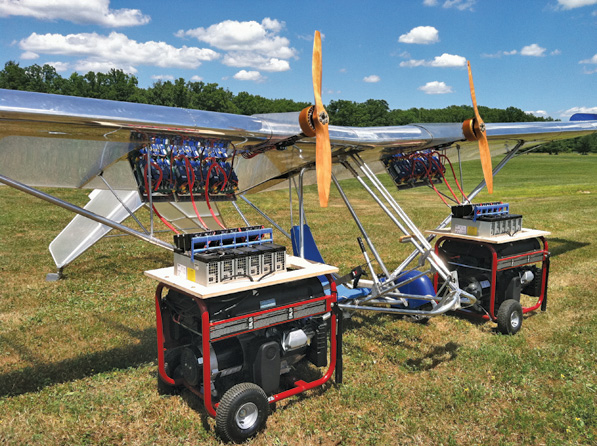
The electric Lazair is outweighed by a support system of gasoline-powered generators and six individual charging systems.
He also employs two portable generators to make up for the fact that most locales will not have a 120-amp electrical service to attach to his power-hungry chargers—each of which pulls 20 amps during its 75-minute recharge cycle for the 7 kilowatt-hour battery system. He is adding a new electrical service panel to his house to allow cheaper recharging at home. Most homes, in fact, cannot support more than 100 amps total. This current draw brings attention to an issue that will be of increasing concern as more types and greater numbers of electric vehicles become prevalent: the need to build a power grid that can cope with growing demands and to create recharging stations that take advantage of solar or other alternative energies. Kramer is taking matters in his own hands with his expedient, but most fliers won’t be willing or able to bring along a motorhome and support equipment to enjoy their hobby. The relatively short charging time from this generator-based system allows more flying and less down time.
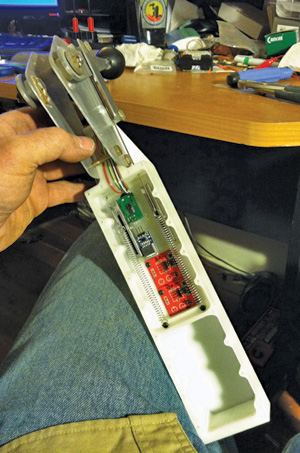
The throttle quadrant, showing Kramer’s attention to detail and prototyping capabilities of his firm, THOHT Mine LLC.
Capturing the Data
Kramer has kept scrupulous records of all flights and has made a spreadsheet to evaluate the data. On “strictly duration flights with no thermals” he calculated that it “takes 1.6 times more power to maintain height in the amphib versus the wheels” configuration. He noted that it took 11 gallons of gas for his generators to “charge the batteries for all this flying,” which totaled 8.9 hours at the time of his analysis; 2.5 hours were on floats, 3.5 on wheels, and 2.9 were in thermal or ridge soaring with the motors off. Even with the fuel burn for the generators, he found he uses less fuel per flight-hour than he did flying this Lazair with two JPX gas engines.
In flight, Kramer uses two Eagle Tree monitors to check motor function and battery status. Batteries start flight at about 63 volts, and by the time they drop to 53 volts, Kramer wants to be on the ground. The monitors are mounted on a piece of wood from siding found at his Hammondsport, New York, home, which was built and owned by aviation pioneer Glenn Curtiss. An Ascent paraglider/hang glider variometer sits on top of the control stick and is the only flight instrument on the aircraft. With reduced charge current from a single outlet in his house’s electrical system, he can recharge the batteries in eight hours. “I am currently ‘greener’ than before electrification,” he said, “and I will be even greener when I get set up to charge with six 20-amp house circuits.” Even charging using the gasoline-powered generators uses only 2.3 gallons per flight-hour for amphibious flying and 1.5 gph for terra firma operations.
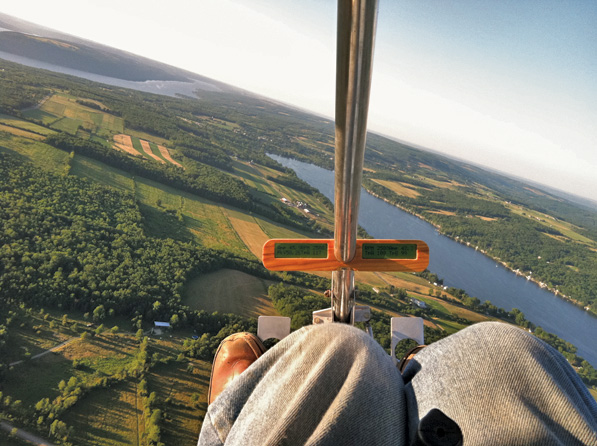
The Lazair on its first flight. The Eagle Tree motor monitors are mounted on a piece of siding from Kramer’s home, once the residence of Glenn Hammond Curtiss, who flew his amphibians from the local lake.
He uses 96 each, four-in-series, 5000 mAh battery packs that cost $32.89 each, delivered. Kramer counts this as “pre-paid gasoline” and notes that he will need only 170 charge cycles to equal the cost of gas and oil for equivalent flying time with fuel. He counts on getting at least 200 cycles from his current batteries, and perhaps as many as 300. His conclusion? “I am convinced that right now it will be cheaper to replace old 185 Rotaxes with an electric setup like this.”
The Show
After getting his feet wet (literally) flying the aircraft as an amphibian, Kramer hauled his Lazair to Oshkosh for AirVenture 2011. Flying out of the ultralight area every morning from 8:30 to 9:00 and every evening from 7:30 to 8:00, he accumulated 4.5 hours over 10 flights and missed only one flying session to attend the World Electric Aircraft Symposium on Friday at the show. He believes this is 10 times the flight time of any other electric aircraft at AirVenture this year.
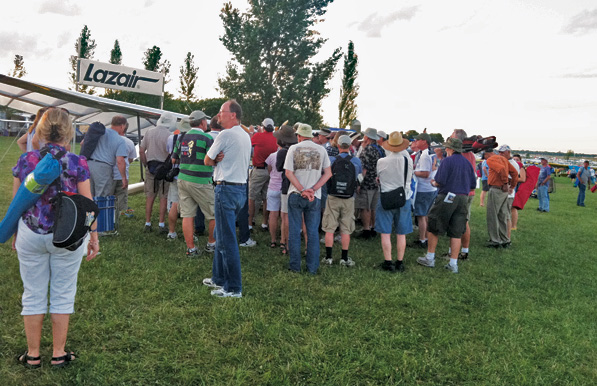
A typical post-flight crowd.
Between aerial excursions, he could rest under the shade of the aircraft’s wings and answer the endless queries of the curious, though he had several hand-lettered signs to address frequently asked questions and guide the discussion.
One sign gave a breakdown of the costs of the project: Joby motors are $1000 each, Jeti-Spin controllers $650 each, and batteries $3300 total. The on-board electrical gear adds up to $6600, while each of the six chargers, derived partly from a computer server power supply, is $300 for a total of $1800. His generators add $1400, but could be offset if a pilot upgraded his or her home electrical panel and recharged from the grid. Motivated individuals could use solar or wind power to recharge without involving a public utility.
Dale Kramer has proven that an electric motor system could replace his original internal-combustion engines, and perform at least as well. To sweeten the deal, if battery life meets Kramer’s anticipated 300 cycles before the packs fall to 75% of rated capacity, he will have flown hundreds of hours at a cost per hour significantly lower than that of a fuel-burning original.
Before AirVenture, Dale Kramer had planned to fly from his home in New York to the Atlantic Ocean, veering south and then west to traverse the United States to the Pacific Ocean before arriving at Oshkosh with his airplane. Maybe he is saving that adventure for some other time. For now, though, he is the most experienced electric amphibian pilot in the world.
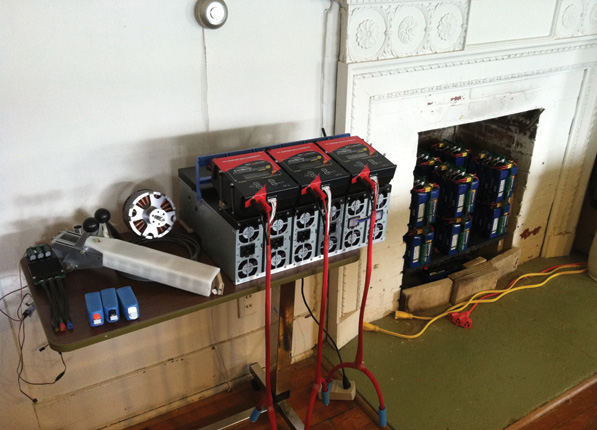
Charging the lithium polymer batteries in the fireplace with the damper open.

![]()
Dean Sigler has been a technical writer for 30 years, with a liberal arts background and a Master’s degree in education. He writes the CAFE Foundation blog and has spoken at the last two Electric Aircraft Symposia and at two Experimental Soaring Association workshops. Part of the Perlan Project, he is a private pilot, and hopes to get a sailplane rating soon.


